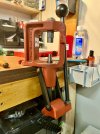RBHarter
West Central AR
Off and on I've been in possession of or using this press since Dad bought it new in 71-72' . It came in a Pacific - Hornady box and is Hornady red but has the Pacific tag on it . The owners manual says it's a Multi Power 'C' , until this morning I was sure it was a 008 .....
The ram isn't stuck and it actually freed up nicely with all the moving parts parts moving . It's been boxed out of service for 20+ years .
Well in my desire to get that last inch of ram slicked up ....... Let's leave it at that was dumb .
The handle block has a stepped shaft and captured links . The links are held with blind roll and step pins that can be removed after the ram is out (stupid was involved in learning this part ) . The only way to get the ram out is to remove the lever/ram connection pin . I'm guessing it has an a stop on one side and a blind snap ring as it doesn't show any other means of retention.
Is there some other means of removing the ram to handle block pin than BH , brute force or 12 ton press ? Some clever hidden paint filled 1/16" pin hole or something?
The ram isn't stuck and it actually freed up nicely with all the moving parts parts moving . It's been boxed out of service for 20+ years .
Well in my desire to get that last inch of ram slicked up ....... Let's leave it at that was dumb .
The handle block has a stepped shaft and captured links . The links are held with blind roll and step pins that can be removed after the ram is out (stupid was involved in learning this part ) . The only way to get the ram out is to remove the lever/ram connection pin . I'm guessing it has an a stop on one side and a blind snap ring as it doesn't show any other means of retention.
Is there some other means of removing the ram to handle block pin than BH , brute force or 12 ton press ? Some clever hidden paint filled 1/16" pin hole or something?

